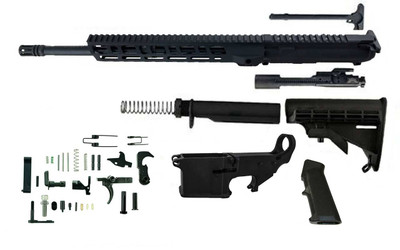

We've got a lot to cover, so we'll keep this short: You want to build an AR-15 from scratch. You might have no idea where to begin. We're going to teach you everything you need to know! The rifle we're piecing together in this guide is a typical AR-15 with a 16" barrel, chambered in 5.56/.223. That's the gold standard for nearly all rifles (the beauty is, you can customize later). First, we'll look at the relevant gun laws and answer some questions you probably have. Next, we'll explain every part you need to build your own AR-15 kit, including which parts are best for a well-rounded, affordable rifle. Lastly, we'll go over the different types of ARs and calibers you can build (a rifle, pistol, or a short-barreled rifle/SBR).
Let's begin! You probably have questions, so we answered the most common ones:
Q: Is it legal to build my own AR-15 at home?
A: Yes, with some restrictions. The ATF has long held that it's 100% legal to build your own AR-15 (and most guns) at home for personal use. You need special paperwork to build a short-barreled rifle (SBR), which is considered an NFA item. We don't need to worry about that right now, we're building a regular rifle.
Q: Do I need an FFL or background check?
A: That depends. If you build your AR-15 using a stripped lower receiver, you'll need to go through an FFL, fill out some paperwork, and conduct a background check. If you're building your rifle or pistol using an 80% lower receiver, you don't need to any of that in most states. Some states require it, like California. Check your local and state laws before building.
Q: Does my AR-15 need a serial number?
A: That also depends. If you buy a stripped lower receiver, it'll have a serial number for paperwork and your background check. 80% lowers do not need a serial number under federal law. The ATF doesn't require a serial number for homemade firearms made for personal use, but some states do. Again, check your local and state laws on this one.
Q: What is an 80% lower receiver?
A: An 80% lower receiver is a firearm blank. You can use one to build your AR-15 at home, and it's what we specialize in. For a complete guide and FAQ on 80% lowers, click here.
If you have more questions about building before getting started, just email or call us. We're happy to help. We'll even get the guy who wrote this guide to help you out, if needed.
The AR-15, regardless of configuration or caliber, can be separated into two major components: The upper receiver assembly, and the lower receiver assembly. You'll need to do some assembly and fitting with parts on the lower receiver, but let's break down all the parts contained in each half, first:
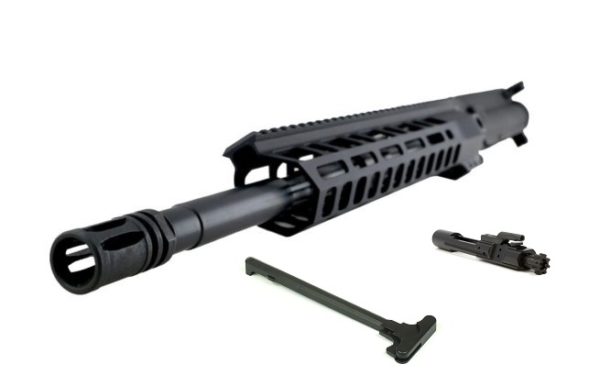
Most barreled upper receivers, like those included with our own build kits, ship preassembled and ready to fire. To make it easy, you can grab one with everything assembled and configured correctly.
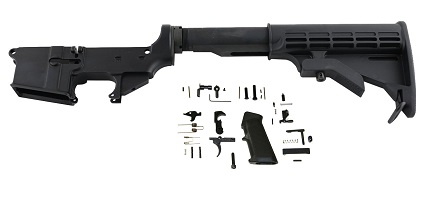
Let's go over all the upper receiver parts you'll need first. They play an important role in shaping how your AR-15 looks and feels. None of these parts are considered firearms, so if you're confident in your choice, you can order your parts and have 'em shipped to your house. No FFL or paperwork is required for any of this stuff.
The barrel is arguably the most important part of your AR build. The barrel determines how accurate your gun is, how far you can shoot, and what rounds you're shooting. You need to consider material (type of steel), finish (the type of coating or treatment), lining (chrome-lined or not), length (which handles velocity), and twist rate (determines what type of rounds you're going to shoot).
Most AR-15 barrels are made from three types of gun steel: 4140 Chromoly, 4150 Chromoly Vanadium (CMV), or 416R stainless steel. The most popular and common barrel choice is 4150 CMV. These barrels most closely match the "mil-spec" requirements of the barrels found in service-issued military rifles. 416R stainless barrels are considered the most accurate. 4140 Chromoly barrels perform admirably for most shooters, and they'll save you some cash.
Most barrels come with a Melonite or anodized coating. These coatings create a matte black finish over the barrel and rifling, protecting it from rust and corrosion. Stainless barrels have no finish, but they naturally resist rust and corrosion. With regular cleaning, a stainless barrel will last just as long (if not out-last) a CMV or Melonite-treated barrel.
Some barrels have their rifling lined with chrome to increase barrel life and to help protect against heat. Melonite is an alternative to chrome-lining and it generally provides better accuracy. Chrome-lining can diminish barrel accuracy slightly but it greatly increases barrel performance, especially with rapid-fire.
Barrel length is a tricky subject. We'll assume you're building a traditional AR-15 chambered in 5.56/.223. To achieve the optimal velocity with the minimum legal barrel length, we recommend sticking with a 16" barrel. This length will afford an optimal velocity of around 2,940 FPS using Federal 62-grain 5.56 ammo. For comparison, stretching all the way out to a 20" barrel only increases velocity by around 120 feet per second.
Twist rate refers to how frequently the rifling completes one full rotation. AR twist rates vary from 1:12, down to 1:7. A barrel with a twist rate of 1:7 completes one full rotation every seven inches. We recommend sticking with a 1:7 or 1:8 twist rate. These rates will reliably handle the most common 5.56 and .223 loads (55-, 62-, and 77-grain).
The gas system in your AR-15 will dictate how your rifle cycles and feeds ammunition. A typical AR-15 operates using direct impingement, illustrated above. This process involves sending excess gas through the barrel, down a gas tube, and back into the upper receiver. The gas is forced into a key atop the bolt carrier group, forcing it backwards. As the BCG rides back, the spent cartridge is ejected and a new round is chambered and ready to fire.
There are four types of gas systems for the AR-15: Rifle, mid-length, carbine, and pistol. We'll keep things simple with a nice chart:

A carbine or mid-length gas system will reliably handle any 5.56 or .223 cartridges you send downrange. Pistol and rifle gas systems are intended for specialty builds, like a subsonic/suppressed AR-15 chambered in 300 Blackout, or a 20"-long bench rifle made for shooting custom loads.
The AR-15 market offers up a two types of handguards: Free-float, and drop-in. A free-float handguard doesn't attach to the barrel or gas block. This increases accuracy by removing stress on the barrel. A drop-in handguard secures to the gas block/front sight post. This provides a more secure fit, and what's the military favors on its service rifles.

[Pictured left, a free-float handguard "floats" over the gas block. Pictured right, a typical Picatinny M4 handguard secures to the gas block/front sight post.]
There are also three attachment systems to pick from: M-Lok, Picatinny, and Keymod. These allow you to attach accessories to your handguard, like flip-up sights, flashlights, and lasers. A flat-face handguard is intended for a precision bench rifle. It has no attachment points and offers an ergonomic, smooth grip that's free of accessories or pointy things.
No matter which handguard you pick, you'll need to make sure it's designed for your AR's gas system. Handguards will describe whether they're for a carbine, mid-length, or other gas system. Picking a handguard that's too short will leave your gas tube and gas block exposed. You can pick a handguard that's longer than your gas system if you want the extra room (pictured above, left). You'll just need to make sure that it's a free-float handguard, not one that attaches to the gas block (pictured right).
Luckily, bolt carrier groups (BCGs) are pretty universal in the AR world. For the sake of building a standard 5.56/.223 shooter, you really only need to pick between a standard AR-15 BCG, or an M16, Full-Auto BCG. We hate to burst your bubble, but an M16 BCG will not transform your semi-auto shooter into a fully automatic blaster. The only difference between the AR-15 and M16 BCG is that one's beefier.

[ Pictured left is an M16 BCG. Pictured right is an AR-15 BCG. Note the difference in material at the back of the carrier. All other dimensions and functions are exactly the same.]
Charging handles are pretty standard fair, too. You can pick up specialty handles with extended grips but otherwise, most charging handles get the job done all the same.
Functionally, all upper receivers are the same for an AR-15 chambered in 5.56 or .223. Regardless of external shape or dimension, most receivers accept all barrels, gas tubes, and BCGs universally. If you opt to build an AR in a different caliber (like 9mm, .308, or 6.5 Creedmor), this will not apply. Upper receivers are typically made of either billet 6061 T6 aluminum, or forged 7075 T6 aluminum. Picking the right stripped upper comes down to personal preference, what sights you want to use, and how you want your rifle to look. There are a few variations of the AR-15's upper receiver:
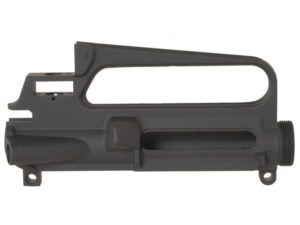
This classic upper features an integrated carry handle and rear sight. If you want to build an original, "mil-spec" M16 clone, this is the receiver you want. The integrated sight mount allows you to install an original M16 rear sight with a narrow and wide aperture. These sights feature MOA-click adjustment and elevation knobs.
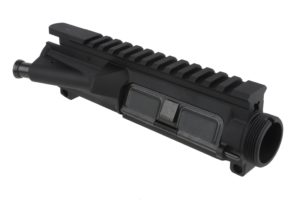
This is by far the most common stripped upper you'll find. It's what nearly all off-the-shelf and custom-built AR-15s use, and for a simple reason: You can install virtually any sight and optic you want. M4 flattop uppers feature traditional Picatinny rails which work with nearly all accessories, iron sights, and scope rings.
This stripped upper is bare-bones, lightweight, and it's often the most affordable option. The basic upper is a stripped-down M4 model that doesn't have a forward assist. Some units won't even have a dust cover. Shooters opt for this receiver because its lighter, simpler, and cleaner in appearance. A forward assist isn't a critical feature on most commercial AR-15s, anyway. It's really only used in a firefight to force the BCG forward in a pinch, usually when it's gummed up with dirt.
Now you know all the parts you need for your upper receiver. At this point, you have a decision to make: Will you build your AR-15 using a stripped lower receiver from a gun store, or will you buy an 80% lower and machine it to make your own stripped lower?

Going with a stripped lower receiver is technically easier. Simply buy one and put all the parts together. However, you'll need to submit to a background check, pay some extra fees to the state and federal government, and you might deal with some extra taxes. There may also be a waiting period before you can pick up your receiver and finish it.
To make deciding easier, we'll refer you to our complete guide on the topic: What is an 80 Lower? Now, let's look at all the parts we need for our lower receiver:
This is another easy part to find and buy. AR-15s chambered in 5.56 or .223 all use generally the same lower parts kits ( like this one). Each kit will need to include the following components:
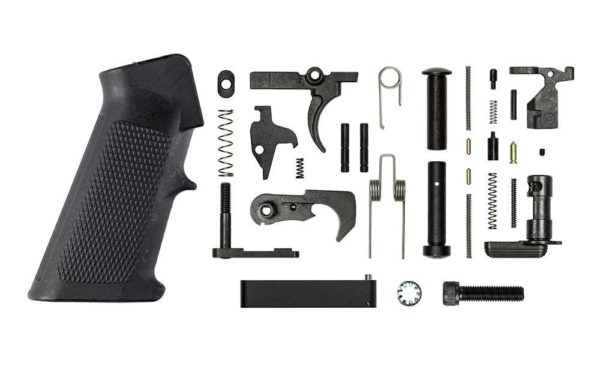
These aren't all the parts that come in a lower parts kit. There are numerous springs, pins, detents, and other little bits and baubles. These are just the "big ticket items" that, if all listed, will get you everything you need for your lower receiver.
The trigger is the most critical component you should consider.
The buffer assembly contains your buffer tube, spring and buffer (which controls the bolt carrier group's recoil), and buttstock. Any time you see the words "commercial" or mil-spec" on a lower receiver, it's referring to the diameter of the buffer tube. Commercial receivers use a 1.17" outer diameter (OD) buffer tube housing, while mil-spec receivers use a 1.14" OD housing.
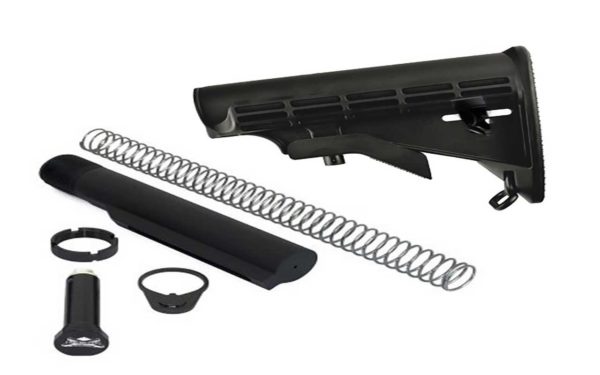
For a regular ole' 16" rifle chambered in 5.56/.223, you'll want a standard buffer tube (sometimes called a carbine tube). A standard tube measures around 7". And inside? You guessed it, you'll need a standard/carbine buffer and spring is perfect. Carbine buffers weigh 3.0 ounces on the dot, so when you're shopping for a buffer, check the weight.
With your buffer assembly figured out, you now have a complete list of  all the parts you need to build your first AR-15 rifle. To make assembly simple, there are some tools you'll want to invest in.
If you opted for a pre-built upper receiver, then final assembly will be a Helluva lot easier. Regardless, there are some tools you'll definitely want to have for the final assembly of your lower receiver and parts kit.
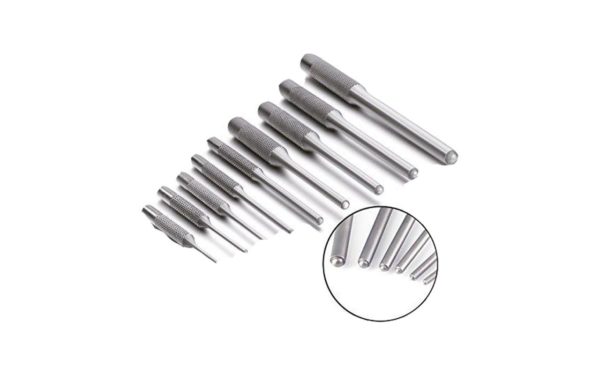
There are roll pins in the lower parts kit that will require the use of special punches to get them seated. Trust us, you do not want to try this without those little punches.
Try it with a screwdriver or nail, and you're 99% likely to send a roll pin flying into the abyss, halting your build in its tracks.
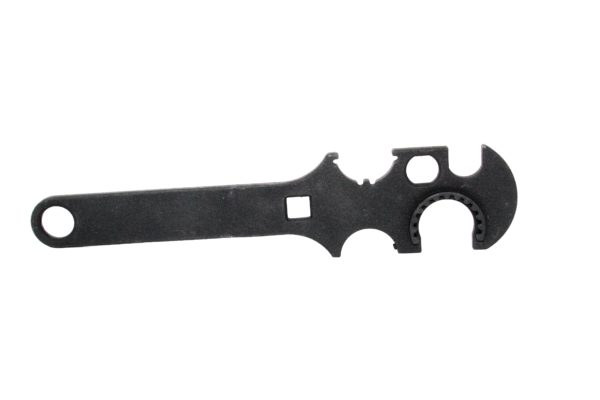
You'll need an Armorer's Wrench to properly install your buffer assembly, and it'll come in handy for installing your handguard. If you're installing your own barrel in your upper receiver - yes, you'll need an Armorer's Wrench for that, too.
With all the parts checked off and all the tools acquired, you should now be well-equipped to piece together your first AR-15. Our guide provided examples for building a regular 16"-barreled rifle chambered in 5.56 or .223. There are other AR platforms you can easily build, too!
The AR-9 pistol uses many of the AR-15's parts, but it also uses proprietary components. You can build an AR-9 using a regular lower receiver, parts kit, and buffer system (though you won't need a buffer tube since any 9mm AR is blow-back operated). AR-9 pistols use a unique bolt carrier group, too. These BCGs fit inside a standard stripped AR-15 upper receiver, but they work with the AR-9 barrel. Most AR-9 BCGs and lower receivers also work with Glock and Colt SMG magazines.
Commonly mistaken as the AR-10, the LR-308 rifle is basically an AR-15 chambered in .308 Winchester or 7.62x51mm NATO. These rifles look and function just like the original ArmaLite-10, but slight differences in the receivers require the use of LR-308 parts. These parts are also commonly referred to as DPMS .308 components. Just as well, you could build an AR-15 chambered in 6.5 Creedmoor, using mostly LR-308/DPMS .308 components. 6.5 Creedmoor is a spiritual successor to the .308, offering better hit probability and performance at 700 meters and beyond.
You can easily swap an AR-15 from 5.56/.223 to 300 Blackout. The .300 BLK round is a versatile round, capable of being fired supersonic, subsonic, suppressed or unsuppressed -- all without making any physical changes to your rifle or the parts installed on it. To convert to 300 Blackout, you'll need a new barrel with the right chamber, and that's it. AR's chambered in 300 Blackout use the same upper and lower receivers, the same parts kit, same BCG, and even the same magazines.
We hope our guide provided you with some direction and knowledge so you can build your own AR-15! Like we said, we're here to help. We don't just sell parts, we love to build our guns in our spare time. If you have any questions about anything in this guide, or simply need help buying the right parts for your build, just call us or email us. We'll be happy to provide info, suggestions, and help. Now get to building!
DISCLAIMER: If you are new to the world of DIY gun building, you likely have a lot of questions and rightfully so. It’s an area that has a lot of questions that, without the correct answers, could have some serious implications. At GunBuilders.com, we are by no means providing this content on our website to serve as legal advice or legal counsel. We encourage each and every builder to perform their own research around their respective State laws as well as educating themselves on the Federal laws. When performing your own research, please be sure that you are getting your information from a reliable source.